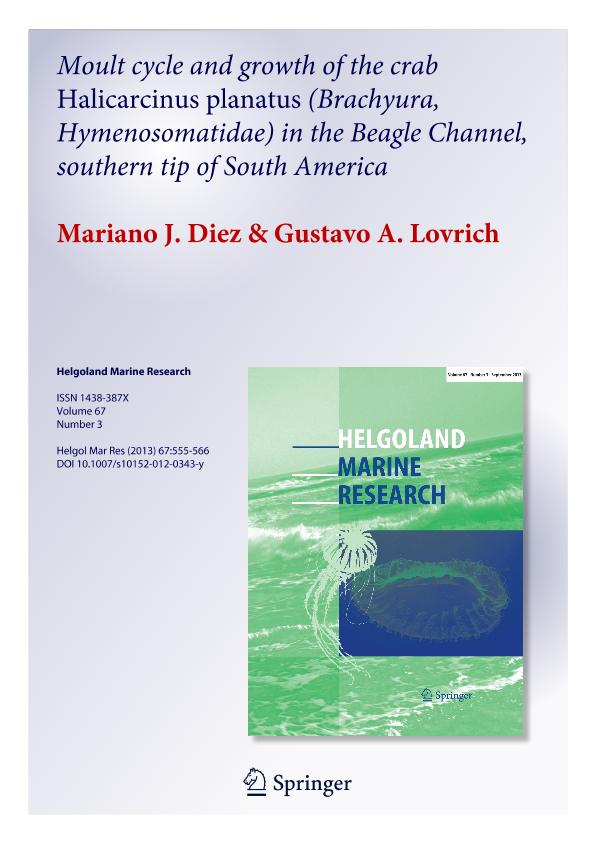Mostrar el registro sencillo del ítem
dc.contributor.author
Diez, Mariano Javier

dc.contributor.author
Lovrich, Gustavo Alejandro

dc.date.available
2017-10-17T17:15:13Z
dc.date.issued
2013-09
dc.identifier.citation
Diez, Mariano Javier; Lovrich, Gustavo Alejandro; Moult cycle and growth of the crab Halicarcinus planatus (Brachyura, Hymenosomatidae) in the Beagle Channel, southern tip of South America; Springer; Helgoland Marine Research; 67; 3; 9-2013; 555-556
dc.identifier.issn
1438-387X
dc.identifier.uri
http://hdl.handle.net/11336/26715
dc.description.abstract
The crab Halicarcinus planatus is the only hymenosomatid crab that inhabits the<br />southern tip of South America and is the only decapod species that reproduces twice a<br />year in the Beagle Channel. In this article, we study the moult cycle in the field (moult<br />frequency, analysis of size frequency distribution) and linked it with growth studied in<br />the laboratory (absolute and percent growth increment, Hiatt function). Hiatt functions<br />were similar for males and females. Moult frequency was seasonal: in early austral<br />spring and in austral summer. In females, the pubertal moult is the terminal moult,<br />whereas males continue moulting after attaining the size of morphometric maturity.<br />Moult increment was highly variable. The relationship between absolute moult<br />increment and crab size was described by a quadratic function. Percent growth<br />increment decreased with size and relationships were different for each sex: linear for<br />females and quadratic for males. Seven and eight modal groups explained the size<br />frequency distributions for females and males from the field, respectively, and revealed<br />the existence of two cohorts of recruits per year. Further modal analysis was mainly<br />hampered by the high variability of size increment that could make any moulting<br />individual fall in its own or one of two following modal groups. The antagonism<br />between growth and reproduction was evident in small males. We hypothesize that the<br />terminal pubertal moult is an advantageous feature that allows females to maximize<br />their investment in reproduction after their terminal moult, which allows this species to<br />have two spawnings per year.
dc.format
application/pdf
dc.language.iso
eng
dc.publisher
Springer

dc.rights
info:eu-repo/semantics/openAccess
dc.rights.uri
https://creativecommons.org/licenses/by/2.5/ar/
dc.subject
Ecdysis
dc.subject
Decapoda
dc.subject
Sub-Antarctic
dc.subject
Terminal Moult
dc.subject.classification
Bioquímica y Biología Molecular

dc.subject.classification
Ciencias Biológicas

dc.subject.classification
CIENCIAS NATURALES Y EXACTAS

dc.title
Moult cycle and growth of the crab Halicarcinus planatus (Brachyura, Hymenosomatidae) in the Beagle Channel, southern tip of South America
dc.type
info:eu-repo/semantics/article
dc.type
info:ar-repo/semantics/artículo
dc.type
info:eu-repo/semantics/publishedVersion
dc.date.updated
2015-06-11T18:20:53Z
dc.identifier.eissn
1438-3888
dc.journal.volume
67
dc.journal.number
3
dc.journal.pagination
555-556
dc.journal.pais
Alemania

dc.journal.ciudad
Berlín
dc.description.fil
Fil: Diez, Mariano Javier. Consejo Nacional de Investigaciones Científicas y Técnicas. Centro Austral de Investigaciones Científicas; Argentina
dc.description.fil
Fil: Lovrich, Gustavo Alejandro. Consejo Nacional de Investigaciones Científicas y Técnicas. Centro Austral de Investigaciones Científicas; Argentina
dc.journal.title
Helgoland Marine Research

dc.relation.alternativeid
info:eu-repo/semantics/altIdentifier/url/https://link.springer.com/article/10.1007/s10152-012-0343-y
dc.relation.alternativeid
info:eu-repo/semantics/altIdentifier/doi/http://dx.doi.org/10.1007/s10152-012-0343-y
Archivos asociados
